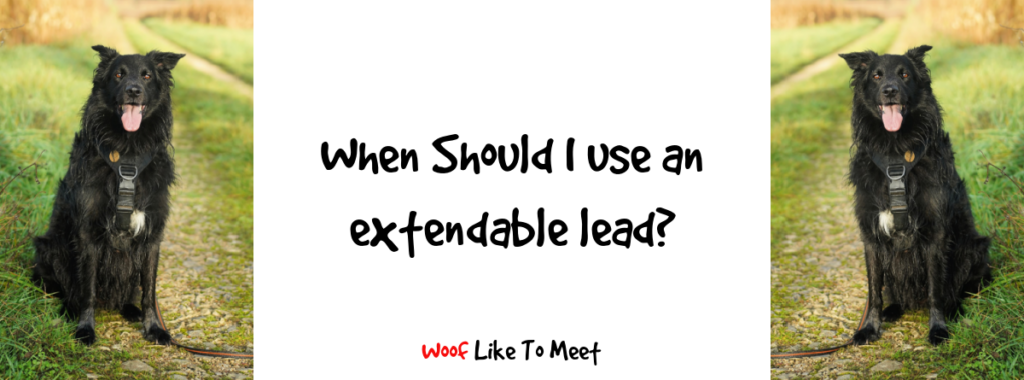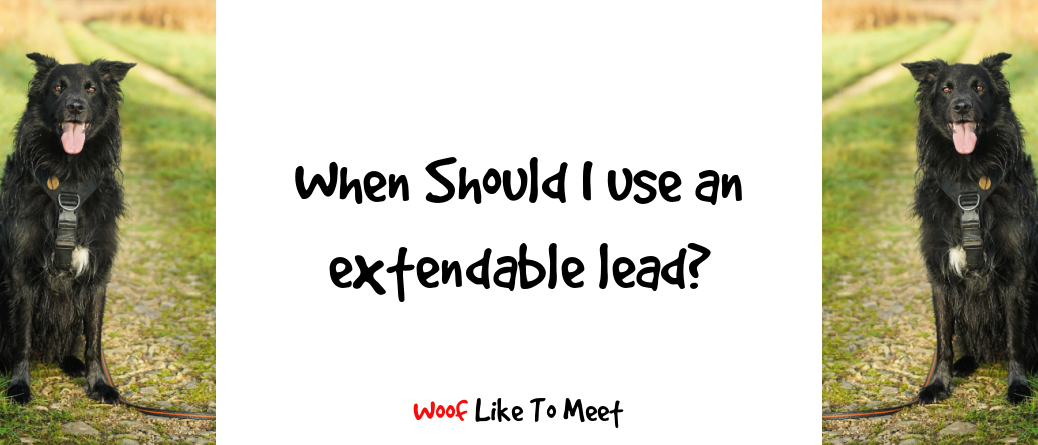
If there is one piece of kit that I wish I saw less of, it would be an extendable lead. These leads, which retract into a plastic handle and are sometimes controlled by a ‘stop’ button that stops the lead spooling in or out are mired in controversy.
Perhaps the question is more in line with when we shouldn’t use an extendable lead.
When shouldn’t you use an extendable lead?
- If your dog pulls at all. Extendable leads exert a constant low-level pressure. This habituates a dog to pulling and teaches them that walking with a lead means accepting a low level of pressure. You will never be able to teach your dog to walk without pulling if they don’t understand that to move forward, they need to move without putting any pressure on the lead.
- If your dog ever chases or is likely to chase things in the environment. These leads can spool out incredibly quickly and the longer the lead, the more momentum your dog can build up. They can very easily whip the lead out of your hand before you’ve even had time to react.
- If you are ever passively supervising your dog on a walk. By this, I mean you check your phone, you watch the birds, you’re talking to a friend, you’re looking at the path. Walking a dog on an extendable lead means constantly and actively supervising your dog. If you don’t do this, the split second you take your attention away from your dog becomes a potential moment when your dog can spool out the lead without you being aware and can potentially end up in trouble.
- If you are ever closer to bicycles, pedestrians, other animals and moving machinery than the maximum length of the lead. It is very easy for any dog on a retractable lead to end up cutting in front of a car, a bicycle or racing up to another dog and getting in a fight. You are reliant on the ‘stop’ button to stop the lead spooling out. If this fails, you are left without any way to prevent your dog getting into trouble and potentially causing injury to others without having to attempt to grab the very thin retractable cord.
- If you don’t walk your dog with every single piece of skin covered, particularly lower arms, hands and legs. Or, if you walk around other humans who haven’t covered all skin. Or, if you walk around other animals who have exposed skin. You don’t even need to risk grabbing the thin cord to cause yourself injury. Friction burns and abrasions caused by the retractable cord are well documented. A simple search engine image search for injuries caused by retractable leads should be enough to put you off for life. Don’t look if you haven’t got a strong stomach.
- If you walk your dog with a neck collar. The potential for your dog to build up a head of steam and either rip the handle out of your hands or cause injuries like whiplash are enormous.
- If you walk your dog with a front-clipping harness. The potential for that cord to cut your dog’s legs or shoulders is significant. Also, front-clipping harnesses are designed for flat leads , not the semi-constant pressure of an extendable lead.
- If you use a choke or prong collar. Both of these are designed for a quick jerk or yank, known by people who use these collars as a ‘correction’. You can’t ‘correct’ a dog when you can’t exert immediate pressure. The pressure from an extendable lead is at a semi-constant if the dog never reaches the end of the lead or you never press the ‘stop’ button. That habituates your dog to a semi-constant, mild pressure and habituates them to the aversive that should be stopping them pulling. Instead of becoming deterrent, it means the dog gets used to a semi-constant level of pressure. Ironically, the pressure of a retractable lead, even pressed stop or at the end of the spool is not enough to put true pressure on the choke or prong so that they function as they should, unless the dog runs into them and builds up a head of steam. The added choke or prong worsens the likelihood of damage in this case. Chokes and prongs were not designed to be used with retractable leads. You might as well not use the choke or prong.
- Head halters. Again, for the same reason. The extendable lead puts a constant pressure on the dog. These are aversive in the first place unless the dog has been habituated to them over a period of time, so adding a low level of pressure to them makes them even more aversive. And like chokes and prongs, using them with a retractable lead never allows you to put pressure on the head halter properly, unless the dog builds up momentum. The risk of injury to your dog in such circumstances is huge.
- If you ever walk more than one dog.
- If you will ever be in a situation where you might need to grab the lead to stop your dog getting into bother.
- If your dog eats things they find in the street, such as other animals’ feces or discarded food as you don’t have the control to be able to stop them or pull them away if necessary.
- If your dog is at all fearful, as the likelihood you will not be able to control the lead if they spook is significant.
- If your dog is at all aggressive or likely to bark, growl, lunge, grab or bite another human or animal.
- If you can’t get your dog’s attention when you call them. Whenever you call them. If you’ve got a dog who hoovers up smells or fixates on things in the distance, then a retractable lead is not the tool you want in a battle with the environment for your dog’s attention.
- If your dog is a puppy. An extendable lead should not be the first lead you introduce your dog to. It is not a training tool. All it teaches is the young dog to get used to constant pressure on the lead and that they can go wherever they want if they pull.
- If your dog has any problem with recall. If you ever lose your dog to the environment, then an extendable lead is not for you. Even if you are very vigilant, if you can’t always get your dog’s attention when you call, then an extendable lead is a liability.
The only time I’d ever use a retractable lead is with a dog under 5kg or so who can walk perfectly on lead and never spools out the cord so that the lead bit is always loose. I’d have to be actively supervising the dog, make sure I’m not around other humans, moving machines or other animals and know that my dog is 100% unlikely to want to interact with them, or anything around them. In such cases, I might as well get a flat lead.
It begs the question as to why people use extendable leads. I think the answer is that they want to give their dogs more freedom to interact with the world and allow their dog to run a little or trot, keep their own pace. Ironically, these are two very good reasons not to use them. Dogs who follow smells or who run on the lead are dogs who can easily build up momentum and end up jerking the lead out of their guardian’s hand.
They are also not good leads for moving to off-lead work. If I’ve been working on recall with a dog, then I’ll often include a ‘trailing lead’ moment where the dog is free but they’re still trailing a lead so that I can intervene if necessary. We sometimes do this when we’ve introduced dogs in the shelter too, as we are less likely to risk a bite if the dogs get into a fight and we can use the leads to control the dogs a little better if we need to by picking up the lead again. Using a dropped lead is often a really good way to move to independence with dogs who have a history of chasing, of not paying attention, or of fearful or aggressive. You can’t do that with a retractable lead.
As you can see, then, barely any single good reason why an extendable lead is the right choice. I accept there may always be exceptions. Normally, I’m fairly relaxed about the kit my clients turn up with bar the heavy artillery like choke chains or prong collars, but I am never okay with an extendable lead. It’s the one time I’ll always swap it out for something more reliable. That said, nobody’s dog is having sessions with me because they’re super obedient. However, all that’s done is made me even more conscious of the problems extendable leads cause and give me all the more reason never to use them.
In the next post, I’ll talk you through using a long flat lead, so that you can work safely with the 17 different kind of dogs who shouldn’t be using an extendable lead. They can carry some of the same risks if you’re not careful with them. And in the post after that, I’ll be looking at ways to teach your dog to walk without pulling.

